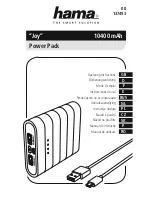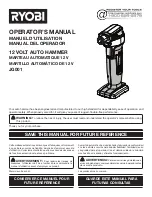
WARNING!
The appliance is not to be used by persons (including children) with
reduced physical, sensory or mental capabilities, or lack of experience and
knowledge, unless they have been given supervision or instruction.
Young children should be supervised to ensure that they do not play with the appliance.
a.
Position yourself and bystanders away from the plane of the rotating wheel.
The guard helps
to protect the operator from broken wheel fragments and accidental contact with wheel.
b.
Only use bonded reinforced cut-off wheels for your power tool.
Just because an accessory
can be attached to your power tool, it does not assure safe operation.
c.
The rated speed of the accessory must be at least equal to the maximum speed marked on
the power tool.
Accessories running faster than their rated speed can break and fly apart.
d.
Wheels must be used only for recommended applications. For example: do not grind with
the side of a cut-off wheel.
Cut-off wheels are intended for peripheral grinding, side forces
applied to these wheels may cause them to shatter.
e.
Always use undamaged wheel flanges that are of correct diameter for your selected wheel.
Proper wheel flanges support the wheel thus reducing the possibility of wheel breakage.
f.
The outside diameter and the thickness of your accessory must be within the capacity rating
of your power tool.
Incorrectly sized accessories cannot be adequately guarded or controlled.
g.
The arbour size of wheels and flanges must properly fit the spindle of the power tool.
Wheels and flanges with arbour holes that do not match the mounting hardware of the power tool
will run out of balance, vibrate excessively and may cause loss of control.
h.
Do not use damaged wheels. Before each use, inspect the wheels for chips and cracks. If
the power tool or wheel is dropped, inspect for damage or install an undamaged wheel.
After inspecting and installing the wheel, position yourself and bystanders away from
the plane of the rotating wheel and run the power tool at maximum no load speed for one
minute.
Damaged wheels will normally break apart during this test time.
i.
Wear personal protective equipment. Depending on application, use face shield, safety
goggles or safety glasses. As appropriate, wear dust mask, hearing protectors, gloves and
shop apron capable of stopping small abrasive or work piece fragments.
The eye protection
must be capable of stopping flying debris generated by various operations. The dust mask or
respirator must be capable of filtrating particles generated by your operation. Prolonged exposure
to high intensity noise may cause hearing loss.
j.
Keep bystanders a safe distance away from work area. Anyone entering the work area must
wear personal protective equipment.
Fragments of work piece or of a broken wheel may fly
away and cause injury beyond immediate area of operation.
k.
Position the cord clear of the spinning accessory.
If you lose control, the cord may be cut or
snagged, and your hand or arm may be pulled into the spinning wheel.
l.
Regularly clean the power tool’s air vents.
The motor’s fan can draw the dust inside the housing
and excessive accumulation of powdered metal may cause electrical hazards.
m.
Do not operate the power tool near flammable materials. Do not operate the power tool
while placed on a combustible surface such as wood.
Sparks could ignite these materials.
n.
Do not use accessories that require liquid coolants.
Using water or other liquid coolants may
result in electrocution or shock.
CARING FOR THE ENVIRONMENT
GENERAL POWER TOOL SAFETY WARNINGS
ELECTRICAL SAFETY
WARNING!
When using mains-powered tools, basic safety precautions, including the following,
should always be followed to reduce risk of fire, electric shock, personal injury and material damage.
Read the whole manual carefully and make sure you know how to switch the tool off in an emergency, before
operating the tool.
Save these instructions and other documents supplied with this tool for future reference.
The manufacturer cannot accept any liability for damage or accidents which arise due to a failure to follow these
instructions and the safety information.
This product has been designed for 230V and 240V only. Always check that the power supply corresponds to the voltage
on the rating plate.
If the supply cord is damaged, it must be replaced by an electrician or a power tool repairer in order to avoid a hazard.
Note:
The supply of 230V and 240V is interchangeable for Australia and New Zealand. This tool is double
insulated in accordance with AS/NZS 62841-1; therefore no earth wire is required.
The power supply for this product should be protected by a residual current device (rated at 30mA or less). A residual
current device reduces the risk of electric shock.
If the supply cord is damaged, it must be replaced by an electrician or a power tool repairer in order to avoid a hazard.
This appliance is not intended for use by persons (including children) with reduced physical, sensory or mental
capabilities, or lack of experience and knowledge, unless they have been given supervision or instruction concerning use
of the appliance by a person responsible for their safety.
Note:
Double insulation does not take the place of normal safety precautions when operating this tool. The insulation
system is for added protection against injury resulting from a possible electrical insulation failure within the tool.
Using an Extension Lead
Always use an approved extension lead suitable for the power input of this tool. Before use, inspect the extension lead
for signs of damage, wear and ageing. Replace the extension lead if damaged or defective. When using an extension
lead on a reel, always unwind the lead completely. Use of an extension lead not suitable for the power input of the tool or
which is damaged or defective may result in a risk of fire and electric shock.
WARNING!
Read all safety warnings and all instructions.
Failure to follow the warnings and
instructions may result in electric shock, fire and/or serious injury.
Save all warnings and instructions for future reference.
The term “power tool” in the warnings refers to your mains-operated (corded) power tool or battery-operated (cordless)
power tool.
1. Work area safety
a.
Keep work area clean and well lit
. Cluttered or dark areas invite accidents.
b.
Do not operate power tools in explosive atmospheres, such as in the presence of flammable liquids,
gases or dust.
Power tools create sparks
which may ignite the dust or fumes.
c.
Keep children and bystanders away while operating a power tool.
Distractions can cause you to lose control.
2. Electrical safety
a.
Power tool plugs must match the outlet. Never modify the plug in any way.
Do not use any adapter plugs with earthed (grounded) power tools.
Unmodified plugs and matching outlets
will reduce risk of electric shock.
b.
Avoid body contact with earthed or grounded surfaces, such as pipes, radiators, ranges and
refrigerators.
There is an increased risk of electric shock
if your body is earthed or grounded.
c.
Do not expose power tools to rain or wet conditions.
Water entering a power tool will increase the risk of
electric shock.
d.
Do not abuse the cord. Never use the cord for carrying, pulling or unplugging the power tool. Keep cord
away from heat, oil, sharp edges or moving parts.
Damaged or entangled cords increase the risk of electric
shock.
e.
When operating a power tool outdoors, use an extension cord suitable
for outdoor use.
Use of a cord suitable for outdoor use reduces the risk of electric shock.
f.
If operating a power tool in a damp location is unavoidable, use a residual current device (RCD)
protected supply.
Use of an RCD reduces the risk of electric shock.
3. Personal safety
a.
Stay alert, watch what you are doing and use common sense when operating a power tool. Do not use
a power tool while you are tired or under the influence of drugs, alcohol or medication.
A moment of
inattention while operating power tools may result in serious personal injury.
b.
Use personal protective equipment. Always wear eye protection.
Protective equipment such as dust mask,
non-skid safety shoes, hard hat, or hearing protection used for appropriate conditions will reduce personal injuries.
c.
Prevent unintentional starting. Ensure the switch is in the off-position before connecting to power
source and/or battery pack, picking up or carrying the tool.
Carrying power tools with your finger on the
switch or energising power tools that have the switch on invites accidents.
d.
Remove any adjusting key or wrench before turning the power tool on.
A wrench or a key left attached to a
rotating part of the power tool may result in personal injury.
e.
Do not overreach. Keep proper footing and balance at all times.
This enables better control of the power tool
in unexpected situations.
f.
Dress properly. Do not wear loose clothing or jewellery. Keep your hair, clothing and gloves away from
moving parts.
Loose clothes, jewellery or long hair can be caught in moving parts.
g.
If devices are provided for the connection of dust extraction and collection facilities, ensure these are
connected and properly used.
Use of dust collection can reduce dust-related hazards.
h.
Do not let familiarity gained from frequent use of tools allow you to become complacent and ignore tool
safety principles.
A careless action can cause severe injury within a fraction of a second.
4. Power tool use and care
a.
Do not force the power tool. Use the correct power tool for your application.
The correct power tool will do
the job better and safer at the rate for which it was designed.
b.
Do not use the power tool if the switch does not turn it on and off.
Any power tool that cannot be controlled
with the switch is dangerous and must be repaired.
c.
Disconnect the plug from the power source and/or the battery pack from the power tool before making
any adjustments, changing accessories, or storing power tools.
Such preventive safety measures reduce the
risk of starting the power tool accidentally.
d.
Store idle power tools out of the reach of children and do not allow persons unfamiliar with the power
tool or these instructions to operate the power tool.
Power tools are dangerous in the hands of untrained
users.
e.
Maintain power tools. Check for misalignment or binding of moving parts, breakage of parts and any
other condition that may affect the power tool’s operation. If damaged, have the power tool repaired
before use.
Many accidents are caused by poorly maintained power tools.
f.
Keep cutting tools sharp and clean.
Properly maintained cutting tools with sharp cutting edges are less likely to
bind and are easier to control.
g.
Use the power tool, accessories and tool bits etc. in accordance with these instructions, taking into
account the working conditions and the work to be performed.
Use of the power tool for operations different
from those intended could result in a hazardous situation.
h.
Keep handles and grasping surfaces dry, clean and free from oil and grease.
Slippery handles and grasping
surfaces do not allow for safe handling and control of the tool in unexpected situations.
5. Service
a.
Have your power tool serviced by a qualified repair person using only identical replacement parts.
This
will ensure that the safety of the power tool
is maintained.
b.
If the supply cord is damaged, it must be replaced by the manufacturer,
its service agent or similarly
qualified persons in order to avoid a hazard.
CUT-OFF SAW SAFETY WARNINGS


























